The NVIDIA GeForce GTX Titan X Review
by Ryan Smith on March 17, 2015 3:00 PM ESTPower, Temperature, & Noise
As always, last but not least is our look at power, temperature, and noise. Next to price and performance of course, these are some of the most important aspects of a GPU, due in large part to the impact of noise. All things considered, a loud card is undesirable unless there’s a sufficiently good reason – or sufficiently good performance – to ignore the noise.
The GTX Titan X represents a very interesting intersection for NVIDIA, crossing Maxwell’s unparalleled power efficiency with GTX Titan’s flagship level performance goals and similarly high power allowance. The end result is that this gives us a chance to see how well Maxwell holds up when pushed to the limit; to see how well the architecture holds up in the form of a 601mm2 GPU with a 250W TDP.
| GeForce GTX Titan X Voltages | ||||
| GTX Titan X Boost Voltage | GTX 980 Boost Voltage | GTX Titan X Idle Voltage | ||
| 1.162v | 1.225v | 0.849v | ||
Starting off with voltages, based on our samples we find that NVIDIA has been rather conservative in their voltage allowance, presumably to keep power consumption down. With the highest stock boost bin hitting a voltage of just 1.162v, GTX Titan X operates notably lower on the voltage curve than the GTX 980. This goes hand-in-hand with GTX Titan X’s stock clockspeeds, which are around 100MHz lower than GTX 980.
| GeForce GTX Titan X Average Clockspeeds | |||
| Game | GTX Titan X | GTX 980 | |
| Max Boost Clock | 1215MHz | 1252MHz | |
| Battlefield 4 |
1088MHz
|
1227MHz
|
|
| Crysis 3 |
1113MHz
|
1177MHz
|
|
| Mordor |
1126MHz
|
1164MHz
|
|
| Civilization: BE |
1088MHz
|
1215MHz
|
|
| Dragon Age |
1189MHz
|
1215MHz
|
|
| Talos Principle |
1126MHz
|
1215MHz
|
|
| Far Cry 4 |
1101MHz
|
1164MHz
|
|
| Total War: Attila |
1088MHz
|
1177MHz
|
|
| GRID Autosport |
1151MHz
|
1190MHz
|
|
Speaking of clockspeeds, taking a look at our average clockspeeds for GTX Titan X and GTX 980 showcases just why the 50% larger GM200 GPU only leads to an average performance advantage of 35% for the GTX Titan X. While the max boost bins are both over 1.2GHz, the GTX Titan has to back off far more often to stay within its power and thermal limits. The final clockspeed difference between the two cards depends on the game in question, but we’re looking at a real-world clockspeed deficit of 50-100MHz for GTX Titan X.
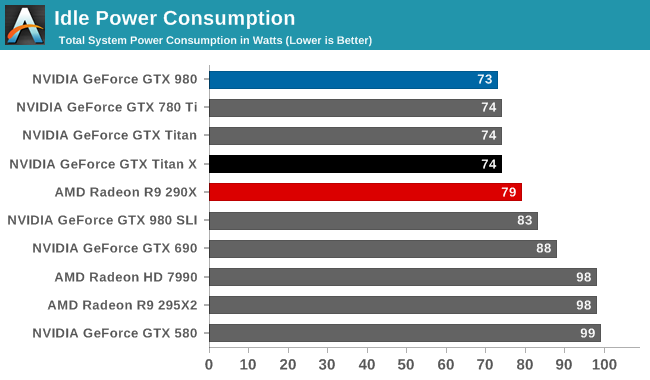
Starting off with idle power consumption, the GTX Titan X comes out strong as expected. Even at 8 billion transistors, NVIDIA is able to keep power consumption at idle very low, with all of our recent single-GPU NVIDIA cards coming in at 73-74W at the wall.
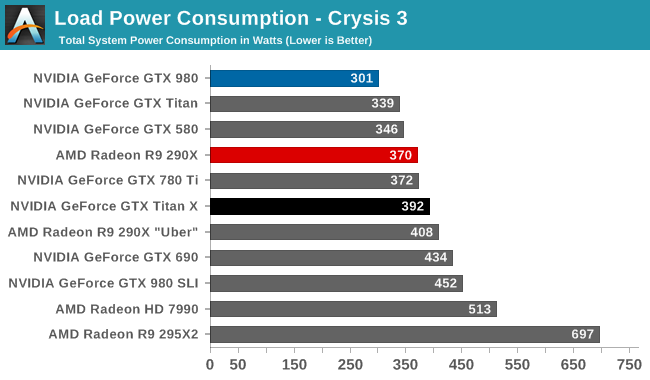
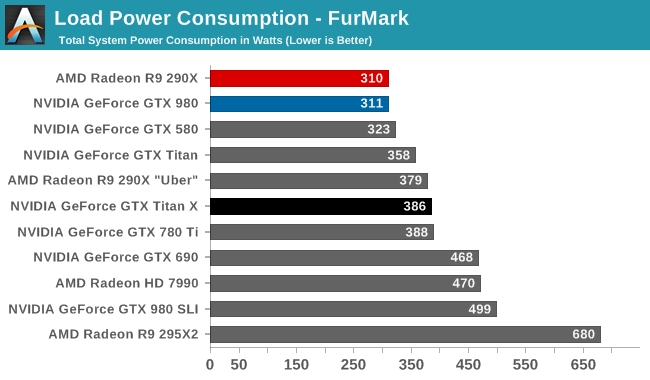
Meanwhile load power consumption for GTX Titan X is more or less exactly what we’d expect. With NVIDIA having nailed down their throttling mechanisms for Kepler and Maxwell, the GTX Titan X has a load power profile almost identical to the GTX 780 Ti, the closest equivalent GK110 card. Under Crysis 3 this manifests itself as a 20W increase in power consumption at the wall – generally attributable to the greater CPU load from GTX Titan X’s better GPU performance – while under FurMark the two cards are within 2W of each other.
Compared to the GTX 980 on the other hand, this is of course a sizable increase in power consumption. With a TDP difference on paper of 85W, the difference at the wall is an almost perfect match. GTX Titan X still offers Maxwell’s overall energy efficiency, delivering greatly superior performance for the power consumption, but this is a 250W card and it shows. Meanwhile the GTX Titan X’s power consumption also ends up being very close to the unrestricted R9 290X Uber, which in light of the Titan’s 44% 4K performance advantage further drives home the point about NVIDIA’s power efficiency lead at this time.
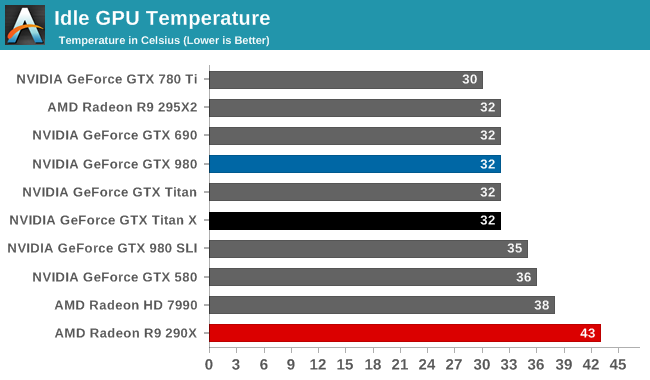
With the same Titan cooler and same idle power consumption, it should come as no surprise that the GTX Titan X offers the same idle temperatures as its GK110 predecessors: a relatively cool 32C.
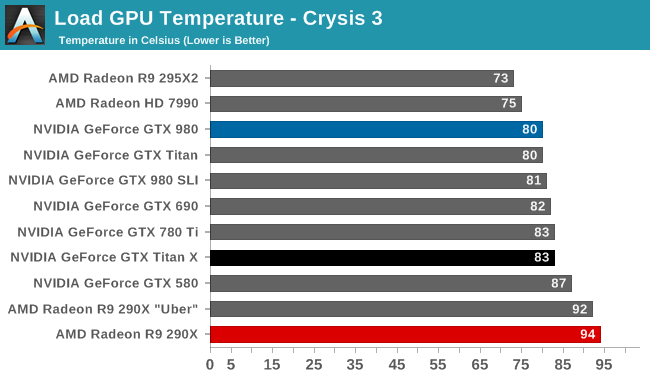
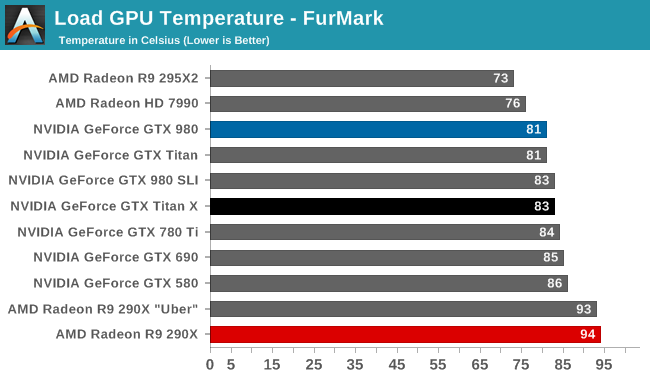
Moving on to load temperatures, the GTX Titan X has a stock temperature limit of 83C, just like the GTX 780 Ti. Consequently this is exactly where we see the card top out at under both FurMark and Crysis 3. 83C does lead to the card temperature throttling in most cases, though as we’ve seen in our look at average clockspeeds it’s generally not a big drop.
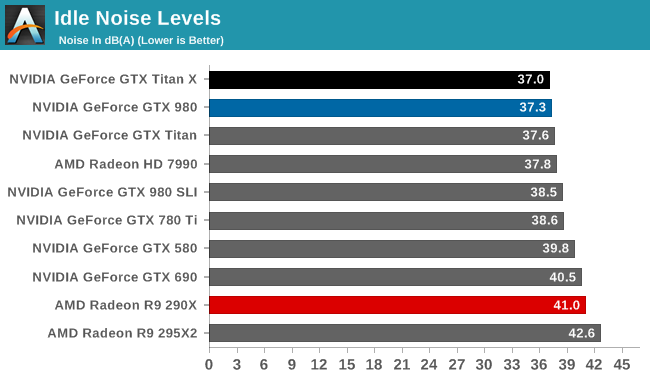
Last but not least we have our noise results. With the Titan cooler backing it, the GTX Titan X has no problem keeping quiet at idle. At 37.0db(A) it's technically the quietest card among our entire collection of high-end cards, and from a practical perspective is close to silent.
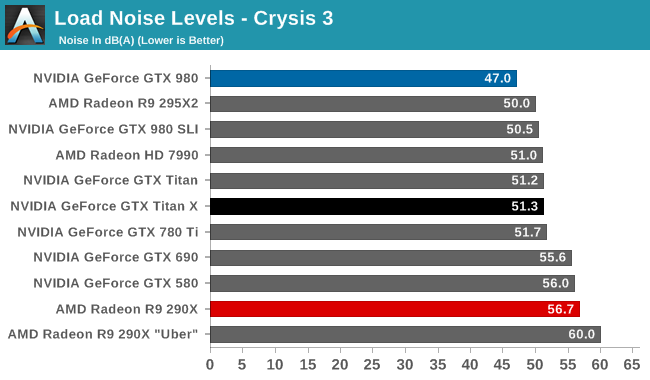
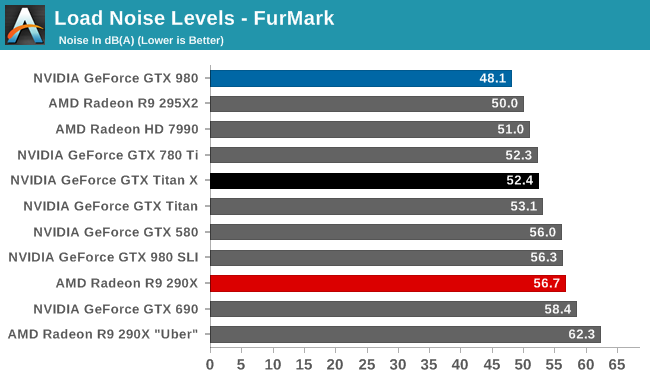
Much like GTX Titan X’s power profile, GTX Titan X’s noise profile almost perfectly mirrors the GTX 780 Ti. With the card hitting 51.3dB(A) under Crysis 3 and 52.4dB(A) under FurMark, it is respectively only 0.4dB and 0.1dB off from the GTX 780 Ti. From a practical perspective what this means is that the GTX Titan X isn’t quite the hushed card that was the GTX 980 – nor with a 250W TDP would we expect it to be – but for its chart-topping gaming performance it delivers some very impressive acoustics. The Titan cooler continues to serve NVIDIA well, allowing them to dissipate 250W in a blower without making a lot of noise in the process.
Overall then, from a power/temp/noise perspective the GTX Titan X is every bit as impressive as the original GTX Titan and its GTX 780 Ti sibling. Thanks to the Maxwell architecture and Titan cooler, NVIDIA has been able to deliver a 50% increase in gaming performance over the GTX 780 Ti without an increase in power consumption or noise, leading to NVIDIA once again delivering a flagship video card that can top the performance charts without unnecessarily sacrificing power consumption or noise.










276 Comments
View All Comments
chizow - Wednesday, March 18, 2015 - link
And custom-cooled, higher clocked cards should? It took months for AMD to bring those to market and many of them cost more than the original reference cards and are also overclocked.http://www.newegg.com/Product/ProductList.aspx?Sub...
Like I said, AMD fanboys made this bed, time to lie in it.
Witchunter - Wednesday, March 18, 2015 - link
I hope you do realize calling out AMD fanboys in each and every one of your comments essentially paints you as Nvidia fanboy in the eyes of other readers. I'm here to read some constructive comments and all I see is you bitching about fanboys and being one yourself.chizow - Wednesday, March 18, 2015 - link
@Witchunter, the difference is, I'm not afraid to admit I'm a fan of the best, but I'm going to at least be consistent on my views and opinions. Whereas these AMD fanboys are crying foul for the same thing they threw a tantrum over a few years ago, ultimately leading to this policy to begin with. You don't find that ironic, that what they were crying about 4 years ago is suddenly a problem when the shoe is on the other foot? Maybe that tells you something about yourself and where your own biases reside? :)Crunchy005 - Wednesday, March 18, 2015 - link
@chizow either way you don't really offer constructive criticism and you call people dishonest without proving them wrong in any way and offering facts. You are one of the biggest fanboys out there and it kind of makes you lose credibility.Crunchy005 - Wednesday, March 18, 2015 - link
Ok wanted to add to this, I do like some of the comments you make but you are so fan boyish I am unable to take much stock in what you say. If you could offer more facts and stop just bashing AMD and praising the all powerful Nvidia is better in every way, despite the fact that AMD has advantages and has outperformed Nvidia in many ways, so has Nvidia outperformed AMD, they leap frog...if you did that we might all like to hear what you have to say.FlushedBubblyJock - Thursday, April 2, 2015 - link
I know what the truth is so I greatly enjoy what he says.If you can't handle the truth, that should be your problem, not everyone else's, obviously.
chizow - Monday, March 23, 2015 - link
Like I said, I'm not here to sugarcoat things or keep it constructive, I'm here to set the record straight and keep the discussion honest. If that involves bruising some fragile AMD fanboy egos and sensibilities, so be it.I'm completely comfortable in my own skin knowing I'm a fan of the best, and that just happens to be Nvidia for graphics cards for the last near-decade since G80, and I'm certainly not afraid to tell you why that's the case backed with my usual facts, references etc. etc. You're free to verify my sources and references if you like to come to your own conclusion, but at the end of the day, that's the whole point of the internet, isn't it? Lay out the facts, let informed people make their own conclusions?
In any case, the entire discussion and you can be the judge of whether my take on the topic is fair, you can clearly see, AMD fanboys caused this dilemma for themselves, many of which are the ones you see crying in this thread. Queue that Alanis Morissette song....
http://anandtech.com/comments/3987/amds-radeon-687...
http://anandtech.com/show/3988/the-use-of-evgas-ge...
Phartindust - Wednesday, March 18, 2015 - link
Um, AMD doesn't manufacture after market cards.dragonsqrrl - Tuesday, March 17, 2015 - link
"use less power"...right, and why would these non reference cards consume less power? Just hypothetically speaking, ignoring for a moment all the benchmarks out there that suggest otherwise.
squngy - Tuesday, March 17, 2015 - link
Undervolting?